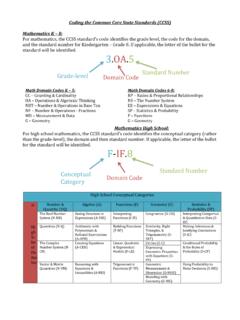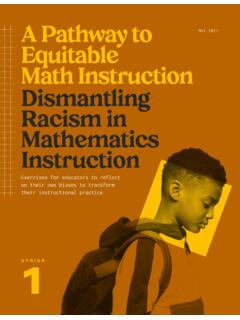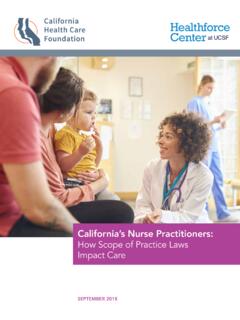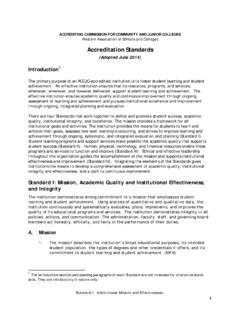Transcription of California Standards for the Teaching Profession (CSTP) …
1 California Standards for the Teaching Profession i California Standards for the Teaching Profession (CSTP) (2009) Commission on Teacher Credentialing October 2009 California Standards for the Teaching Profession (2009) ii Commission on Teacher Credentialing State of California Arnold Schwarzenegger, Governor Members of the Commission Caleb Cheung, Chair Teacher Representative Margaret Gaston, Vice Chair Public Representative Constance Baumgardt Blackburn Teacher Representative Josephine Calderon Public Representative Marlon Evans Public Representative Charles Gahagan Teacher Representative Steven Dean Teacher Representative Leslie Littman Designee, Superintendent of Public Instruction Carolyn McInerney School Board Member Irene Oropeza-Enriquez Administrative Services Representative David Pearson Faculty Representative Ting Sun Public Representative Ex Officio Representatives Shane Martin Association of Independent California Colleges and Universities Marilyn T.
2 McGrath California Postsecondary Education Commission Tine Sloan University of California Beverly Young California State University Executive Officer Dale A. Janssen Executive Director California Standards for the Teaching Profession (2009) iii California Standards for the Teaching Profession Advisory Panel (2008-09) Name Employer Representing Priscilla Cox Elk Grove USD CSBA Cindy Gappa Tehama COE ACSA Gail Kirby St. Mary's College AICCU Eloise Lopez Metcalfe University of California , Los Angeles UC Theresa Monta o California State University, Northridge CTA Susan Rich Stanislaus COE CCESSA Sue Westbrook California Federation of Teachers CFT Ruth Yopp-Edwards California State University, Fullerton CSU Wendy Baron Santa Cruz COE/New Teacher Center at UC Santa Cruz Michelle Cepello California State University, Chico Lewis Chappelear Los Angeles USD Nancy Farnan San Diego State University Helen Garcia Rockett California State Polytechnic University, Pomona Ira Lit Stanford University Paula Lovo Ventura COE Robert McClurg Rescue USD Betty McEady Chapman University College Cara Mendoza Fairfield-Suisun USD Marisol Rexach Santa Ana USD Luis Rodriguez Los Angeles USD Jodie Schwartzfarb New Haven USD Steve Turley California State University.
3 Long Beach Andrea Whittaker San Jose State University Ting Sun Commission Liaison Staff Working with the CSTP Advisory Panel Terry Janicki Commission on Teacher Credentialing Karen Sacramento Commission on Teacher Credentialing Teri Clark Commission on Teacher Credentialing Edna Shoemaker California Department of Education Ellen Ringer California Department of Education California Standards for the Teaching Profession California Standards for the Teaching Profession (2009) iv (CSTP) (2009) Table of Contents Introduction ..1 A Holistic and Developmental Vision of Context of Teaching in History of the California Standards for the Teaching ..3 Organization of the Standards ..3 Conclusion ..4 Standards Standard 1: Engaging and Supporting All Students in Standard 2: Creating and Maintaining Effective Environments for Student Learning ..7 Standard 3: Understanding and Organizing Subject Matter for Student Standard 4: Planning Instruction and Designing Learning Experiences for All Standard 5: Assessing Students for Standard 6: Developing as a Professional Educator.
4 16 California Standards for the Teaching Profession (2009) 1 California Standards for the Teaching Profession (CSTP) (2009) A growing body of research confirms that the quality of Teaching is what matters most for students development and learning in schools. Teaching is a professional endeavor, one in which effective practice is driven by an understanding of knowledge in the field and a commitment to all students and their families. Excellent Teaching requires knowledge, skills, artistry, passion, and commitment. Effective teachers integrate the following: (1) ethical concern for children and society; (2) extensive subject matter competence; (3) thoughtfully selected pedagogical practices ; and (4) a depth of knowledge about their students, including knowledge of child and adolescent development and learning; an understanding of their individual strengths, interests, and needs; and knowledge about their families and communities.
5 Effective Teaching requires careful crafting of learning communities built on trust and respect, as well as routines, expectations, resources, and strategies that support diverse students intellectual engagement in learning. Effective Teaching happens through thoughtful planning focused on defined outcomes for student learning and leveraging of teachable moments. Effective Teaching is revealed in the ways in which teachers respond to the strengths and needs of individual students while engaging and supporting all students in their learning. Effective Teaching is a form of inquiry wherein teachers use evidence and analysis of students strengths and struggles, and their own performance, to guide their practice in support of student learning. Effective Teaching relies on engagement within a professional community. Moreover, effective Teaching requires the ability to successfully integrate elements of the professional knowledge base in the service of learning, growth, and development of diverse students across varying contexts.
6 Finally, effective teachers share a common set of professional and ethical obligations that includes a profound and fundamental commitment to the growth and success of the individual students within their care as well as to the strengthening and continual revitalization of our democratic society. The California Standards for the Teaching Profession (CSTP) are intended to provide a common language and a vision of the scope and complexity of the Profession by which all teachers can define and develop their practice. The Standards seek to serve and support professional educators in fulfilling their professional roles and responsibilities from pre-service teacher to experienced practitioner. The Standards are not set forth as regulations to control the specific actions of teachers, but rather to guide teachers as they develop, refine, and extend their practice. The CSTP have been used for a variety of purposes, including the following: to prompt reflection about student learning and Teaching practice; to formulate professional goals to improve Teaching practice in support of student learning; and to guide, monitor, and assess the progress of a teacher s practice toward professional goals.
7 A Holistic and Developmental Vision of Teaching The CSTP comprise a set of Standards for the Teaching Profession in six interdependent domains of practice. While the Standards are addressed separately in this document, Teaching , as defined above, is clearly a holistic and integrated endeavor, consisting of the complex combination of interrelated parts. Teaching and learning are affected by many factors that are both intrinsic and external to the classroom. A vision of effective Teaching equitably distributed in service of California Standards for the Teaching Profession (2009) 2 California 's diverse student populations must therefore emphasize relationships among multiple aspects of Teaching and learning. Teaching is more than methodology. A teacher s understandings of student development, of families and communities, of subject matter and curriculum, and of instructional methods, strategies, and resources are ultimately linked to how the teacher plans and implements instruction and assesses student learning.
8 Ethical, philosophical, and theoretical understandings of learning and Teaching empower teachers to make thoughtful, informed decisions about instructional strategies and ways to support students learning and development. The California Standards for the Teaching Profession are broad and interconnected because the professional practice of Teaching must be understood comprehensively as a complex, dynamic process in which practical and conceptual elements are woven together in a seamless fabric. Teachers knowledge, skills, and practices develop throughout their professional careers and across changing contexts. To engage and challenge a diverse student population in a rapidly changing and increasingly technological world, effective teachers require continuous professional growth. Teachers are never finished as professional learners, no matter how extensive or excellent their formal education, preparation, and experience.
9 If teachers expertise, capabilities, and accomplishments are to be enriched over time, they must be reflective and actively seek to strengthen and augment their professional knowledge, skills, and perspectives in support of student learning. A developmental view of Teaching gives particular attention to the early years of each teacher s career. Beginning teachers move forward in their professional practice in a variety of ways, developing at different rates in different areas of Teaching , just as students develop at individual rates in different curricular areas. Effective support, mentorship, assessment, and advanced study during the early years of Teaching (including teacher preparation) are essential to a beginning teacher s development and success in the Profession . Individual teachers enter and advance through the Profession at different levels of experience and expertise, in varied roles, and in varying contexts. The policies and practices of teacher preparation programs, certification bodies, and school districts must be guided by clear and realistic Standards regarding professional performance.
10 The CSTP describe a vibrant vision of practice for the Teaching Profession . Teachers across the Profession with varied levels of prior preparation and experience -- and the mentors, colleagues, and supervisors who support them -- will find the Standards useful to guide their developing practice. The California Standards for the Teaching Profession reflect a developmental view of Teaching , and are an integral part of California s efforts to foster excellence in Teaching and learning. Context of Teaching in California Professional educators in California serve an increasingly diverse population of students. This diversity among students greatly enriches and enlivens the educational experience for teachers and students alike. Therefore, there is a critical need for teachers who are responsive to the varied socio-cultural, racial, religious, ethnic, linguistic, and economic backgrounds of all students and who consider how learning differences and abilities, gender and gender identity, family structure, sexual orientation, and other aspects of humankind influence learning and Teaching .

















